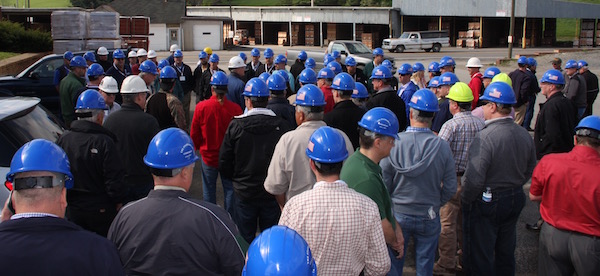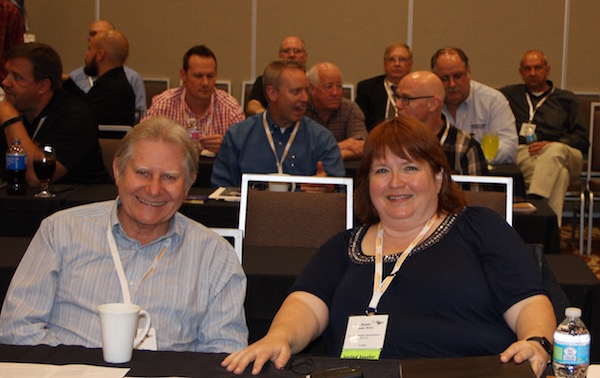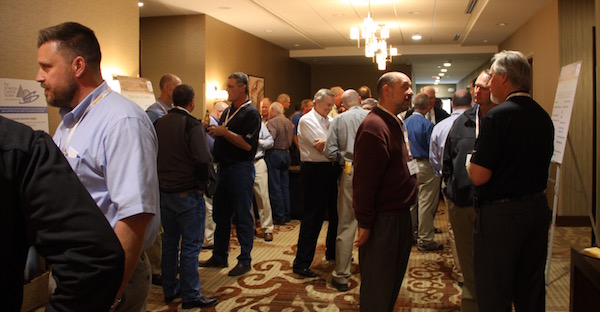
[Image above] Structural Clay Products Division attendees properly attired for its tour of The Belden Brick Company (Sugarcreek, Ohio). Credit: ACerS.
I had the pleasure of attending the Structural Clay Products Division meeting in North Canton, Ohio, on Monday, May 3. The SCPD coordinates their division meeting with the National Brick Research Center, which is headquartered at Clemson University in South Carolina.
More than 80 people—mostly brick manufacturers and industry suppliers—attended. The half-day technical program covered pending EPA regulations, testing, pigment engineering, and façade and thin brick production. The National Brick Research Center held its membership meeting after the SCPD activities finished.
Susan Miller (Brick Industry Association) commanded the attention of all as she walked the group through the latest developments regarding the “Brick MACT” rule issued by the U.S. Environmental Protection Agency. MACT is the Maximum Achievable Control Technology and is used to set a NESHAP—National Emissions Standard for Hazardous Air Pollutants. According to Miller, hydrofluoric acid and hydrochloric acid are the only two hazardous air pollutants that the brick industry emits in large enough amounts to fall under the regulation. There are three options: reconsideration (get the law changed by Congress), litigation (delays the compliance timeline while legalities are argued), or compliance. Companies have three years to comply once the clock starts ticking, and compliance can be costly. The Brick Industry Association has been working to get the law changed and is making some progress on that front. Several groups, including the BIA, have begun litigation processes, which are far from resolution.
Rutgers professor Richard Riman challenged the group to think about a new disruptive technology based on carbonation reactions as opposed to hydration reactions to harden ceramics. The process, he explained, is similar to the natural formation of stalagmites and stalagtites. “We’re just making stuff that nature wants us to make anyway,” he says of his technology.
ACerS president Mrityunjay Singh, who works about an hour away from the meeting’s location, took the opportunity to attend and greet the Division and its NBRC colleagues.
Adhering to SCPD tradition, the second day of the division meeting featured a plant tour and lunch. This year’s host was The Belden Brick Company in Sugarcreek, Ohio. The family-owned business was founded in 1885 and is run by Robert Belden, a fourth-generation Belden brickman. If you are a University of Notre Dame alum or fan, you’ll be interested to know that Belden Brick has supplied UND with its brick for decades.
Details about the where and when of next year’s SCPD meeting are to come, so stay tuned for more information. Meanwhile, here are some photo highlights from SCPD 2016.

Robert Belden at the podium presents The Belden Brick Company to 84 attendees at the Structural Clay Products Division Meeting. Credit: ACerS

ACerS president Mrityunjay Singh welcomes the group to Ohio, his home state. Credit: ACerS

Two speakers on the technical program: Garth Tayler (left) of Acme Brick and Susan Miller (right) of the Brick Industry Association. Credit: ACerS

Any “meeting” must include meeting new friends and old during networking breaks. Credit: ACerS

Bill Daidone, division chair, receives a certificate of appreciation from John Hewitt, SCPD chair-elect. Credit: ACerS

Yes, folks, that’s a beehive kiln. Bob Belden, president and CEO of Belden Brick (white hat), explains how it works to ACerS membership director, Kevin Thompson (blue hat). Credit: ACerS

Setting green brick in the beehive. Credit: ACerS

Robots provide much of the muscle in a brick plant. Credit: ACerS

Kevin Thompson, ACerS membership director, realizing he should have studied ceramic engineering in college. Credit: ACerS
